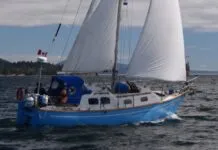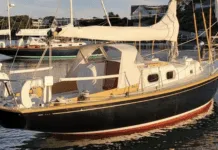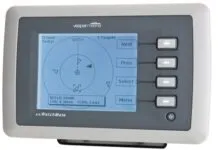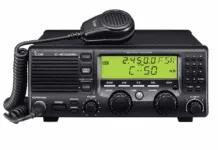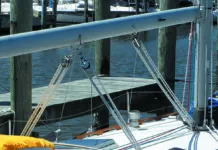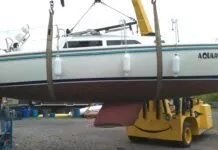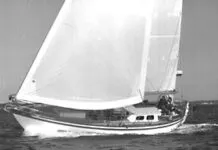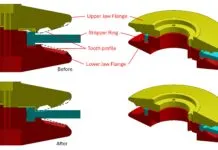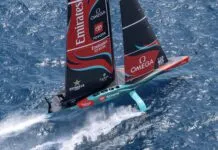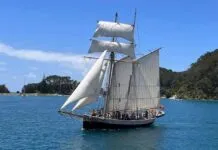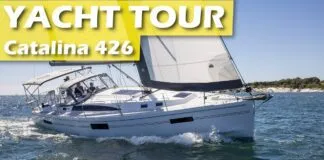Yes, it’s again time to look at handheld GPS receivers, which have now officially become a consumer commodity. Sales of receivers to hikers, bikers, and drivers have already surpassed those made to boaters, and GPS manufacturers have shifted their focus with regard to the design of their receivers and the features that they include.
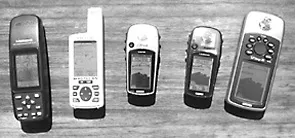
Gone are the days when sailors were a favored market. The ultimate goal of GPS manufacturers is to sell more units, and gearing receiver interfaces specifically to the needs of pleasure-boaters just won’t cut it. As a result, sailors are left, for the moment, with a lot of features we don’t need, and without some that we do need. This won’t be the case for too long. More and more, the utility of these receivers for niche markets is determined by the software loaded into them. The time will come when we’ll have what we need again. It’s just not now.
So consider this a report about an interim generation of handheld receivers—and not even the full generation. There’s just too much churn among models and capabilities to try to do comprehensive articles on the topic any more.
Performance: A Gimme
The technology used in the design of GPS receivers has become very mature. Early models varied widely in receiver performance and even in accuracy. Current models all perform exceptionally well on both counts. The type of accuracy testing and receiver sensitivity measurements that we previously performed no longer yield results that can significantly separate “good” models from “better” models. Our current reviews now focus on functionality, features, ergonomics and most importantly, appropriateness for marine use.
The latest developments with GPS equipment have been the standard inclusion of cartography (mapping) with all but the least expensive models. This has been facilitated by the crash in computer memory prices, increased processor power and better display technology. Changes in the actual GPS “engine” are now rare. In fact, very shortly GPS will be routinely installed into other products such as cellular phones. The added accuracy provided by WAAS even opens up the probability of soon having GPS-guided lawn mowers and other devices which use GPS technology as a secondary component to assist in their operation.
Handheld GPS receivers have progressed by shrinking in size and being packed with ever more features. These two strategies, however, are not necessarily mutually compatible. Features need to be usable, not to mention visible. The smaller displays now found in most GPS receivers simply cannot do justice to their capabilities. Some current models now reach the limit of even being large enough to control, view and hold comfortably.
The combination of small size and increased display information are particularly incompatible. Intricate map details simply are not adequately visible on small handheld displays. In a pitching sailboat or fast-moving powerboat (especially the latter), the area visible on these small displays is simply not adequate for safe navigation.
However, as more and more information shows up on GPS displays, so does the tendency to ignore official paper charts. In other words, when GPS simply provided coordinates, we tended to keep the receiver near a chart and use it to locate our position on that chart. Now, many boaters simply bypass the paper chart and rely solely on the information on their GPS display. Unfortunately, this information is often simply wrong. We have often found misplaced buoy locations on GPS cartography. Even their land maps have errors such as incorrect route numbers and mislocated features.
We’ve said it before, but we’ll say it again: A handheld GPS receiver should not be the primary means of navigation on board—much less the sole means.
Our evaluation of several current models follows.
Lowrance Globalmap 100
The Lowrance Globalmap 100 is a full-featured handheld cartographic GPS receiver. At 6.75″ long it was the largest of the models that we tested. Its display is centrally located below a slightly slanted patch antenna and above its 12-key control pad. This arrangement puts the display right under your thumb and the keys out of reach without sliding the unit upward in your hand. Furthermore, when being held so as to use its controls it becomes unbalanced and top-heavy.
Display visibility was very good and interface operation straightforward. although not as intuitive (to our intuition, anyway) as any of the Garmins or the Magellan.
Map loading times and screen updates seemed slower than other models. During testing, location accuracy was within normal limits for a non-WAAS receiver.
The Globalmap 100 is powered by 4 AA batteries, double the number required by other models. A data connector and external antenna connector are located below the unit’s antenna. These are protected by removable plastic covers that are not otherwise attached. We give them about a week before being lost.
The battery compartment is not waterproof and no claims concerning the waterproofness of the rest of the unit are made by Lowrance.
Lowrance does include its “Map Create Series 4” CD-ROM, which includes both terrestrial and marine map data that can easily be downloaded into the unit. This feature is our preferred approach and allows users to customize the data in their receiver without needing to invest any money in addition to buying the receiver. We do however, question the currency and accuracy of the data provided on this CD, although that’s not to single out Lowrance—it goes for Garmin and Magellan as well.
Bottom Line: The Lowrance Globalmap 100 is an obviously dated design. It doesn’t approach the state of the art in this category, and lacks WAAS compatibility. We cannot recommend it.
Lowrance is due out any minute with a new GPS receiver called the “iFinder™.” We’ll look forward with great interest to this new product, to see if it helps put Lowrance firmly back into the game—we can use the competition.
Garmin eTrex Vista & Legend
Garmin’s eTrex Vista and Legend are similar models placed in their awardwinning miniature eTrex handheld package. Each is controlled by two pushbuttons on the right side, three more on the left side, and a unique “Click Stick” located exactly where your thumb would land if it were being held in your left hand. The Click Stick functions as a combination joystick and pushbutton. It produces a clicking sound with each motion to provide positive feedback. The eTrex’s display is small but of very good quality and very well lit for nighttime viewing. Both models include all of the standard GPS features that we expect, as well as WAAS compatibility. The Legend is less expensive and includes 8 MB of internal memory. It is made in a very distinctive translucent blue color. The included map data is not very detailed but more information can be loaded from Garmin’s optional Map Source CD ROMs.

The eTrex Vista adds 16 MB of internal memory (24 MB total), barometer, barometric altimeter, and a fluxgate compass. Its added memory allows it to store an amazing amount of information such as highway exit data, location of gas stations, and much else. Unfortunately, little of this pertains to the needs of a marine user—unless, of course, you’re running low on fuel on the way to the marina.
Both Legend and Vista include a data transfer cable and operate on 2 AA batteries. Position, speed, and bearing accuracy were all excellent. WAAS reception worked flawlessly. Our primary complaint is the lack of an external antenna connector.
Bottom Line (eTrex Legend): The Legend is a top-notch handheld GPS receiver available at low cost. It is an excellent general-purpose model but not marine-specific.
Bottom Line (eTrex Vista): The Vista is an amazing piece of electronics. It’s extremely well designed and built. We recommend it highly—but remember that it’s not exactly designed for marine navigation.
We didn’t do a separate evaluation of the eTrex Mariner, sold exclusively by West Marine. The Mariner is a variation on the eTrex Venture; it uses the same database of Aids to Navigation that we evaluated on the Legend and Vista models used in these tests, but comes pre-loaded with that data from the factory. And it’s yellow.
Garmin GPSmap 76
The Garmin GPS Map 76 is a larger handheld cartographic GPS receiver. It is the evolutionary product of Garmin’s GPS designs other than the eTrex series. It is, despite being larger than the eTrex models, quite compact, equally ergonomic, and well designed. Its larger display makes it easier to read at arm’s length and while bouncing around in the waves. Its display is very readable and well-lit. However, too much data displayed at low magnifications makes it appear cluttered and hard to read. In crowded urban areas such as the Baltimore harbor, this is especially evident.
The GPS Map 76 is controlled by eight pushbuttons and a rocker switch, which are centrally located above its display. One-handed operation is easy without obstructing the display or antenna. An external antenna connector and data connector are covered by attached rubber covers. During testing the GPS Map 76 performed flawlessly. Position accuracy was consistently within 3 meters of our test marks.
Bottom Line: This model differs from the ETrex series by being more attractive to the experienced navigator and GPS user. While it lacks several of the features of the eTrex Vista, its larger display and more detailed chart data make it more functional in a marine environment. The GPS Map 76 operates on 2 AA batteries.
Magellan MAP330M
The Magellan MAP330M is that company’s entry as handheld receiver specifically designed for the marine market. However, we can’t find much hardware difference between the 330M and the standard 330 model. The 330M even includes Magellan’s Map Send Streets CD. For an item marketed to marine users, we would expect something more devoted.
The marine MAP 330M fits nicely in one hand. Its helical antenna protrudes from above its display. Its controls include a four-way rocker pad, two-way rocker switch, and six pushbuttons. These are located on the bottom third of the receiver. This arrangement is not ergonomically perfect, but still is quite usable.
Unlike the Lowrance GlobalMap 100, the Map 330’s light weight does not make it unbalanced when operating its controls. The 330M’s display is adequate but not as crisp as Garmin’s. Nav-aids appear very cluttered and are unusable at lower magnifications. At higher magnification levels with short distances displayed, buoy and nav-aid data is quite legible.
This model is powered by 2 AA batteries. During testing it performed well. Accuracy, including WAAS corrections, was within expected limits. The marine data included is average. Our usual concern about the accuracy and currentness of the information shown applies.
Bottom Line: The Magellan MAP330M is well made and functional. While not our first choice, it is inexpensive and works well. It’s important to note that this model will soon be replaced by Magellan’s Meridian series of receivers.
Conclusion
Garmin is without doubt the current leader in the handheld GPS arena. Magellan is second, but may catch up with the introduction of their new models.
In this batch of receivers, the Garmin GPSmap 76 is our Best Buy for marine use, based on larger display and external antenna connection. Garmin eTrex Vista is the most feature-rich but also the most expensive.
Our primary concern with all these handhelds is the inclusion of too much in too small a package. The cartographic capabilities of these receivers is minimal and sometimes badly inaccurate or misleading—and yet these receivers tend to push us away from paper charts. This will eventually lead to disaster. None of the receivers is designed to favor the mariner over the hiker or the delivery driver.
On the positive side, technology is moving very quickly. Let’s hope the next generation arrives soon.
Contacts— Garmin International, 1200 E. 151st St., Olathe, KS 66062; 800/800-1020; www.garmin.com. Lowrance Electronics, Inc., 12000 E. Skelly Dr., Tulsa, OK 74128-2486; 800/324-1354; www.lowrance.com. Magellan, Thales Navigation, 960 Overland Court, San Dimas, CA 91773 909/394-5062; www.thales-navigation.com/.
Also With This Article
Click here to view “Value Guide: 5 Handheld GPS Receivers.”
Click here to view “Handheld GPS Wish List.”



